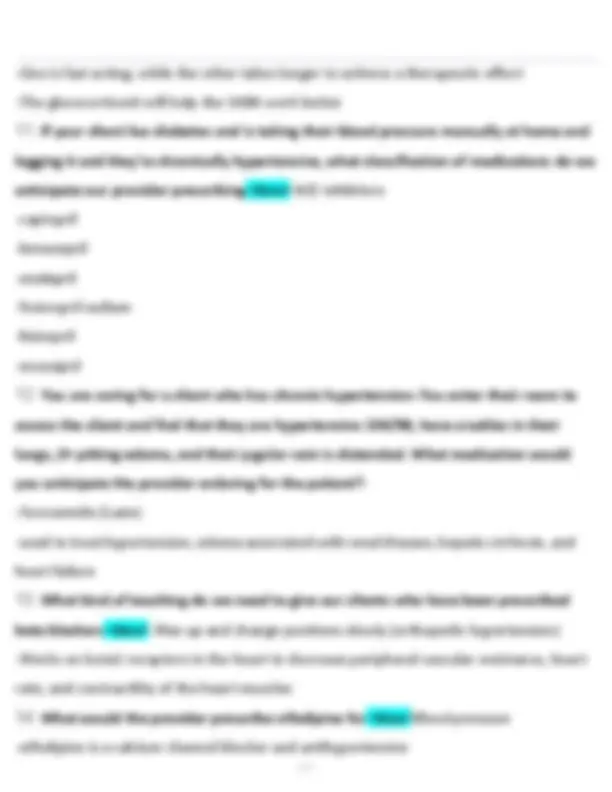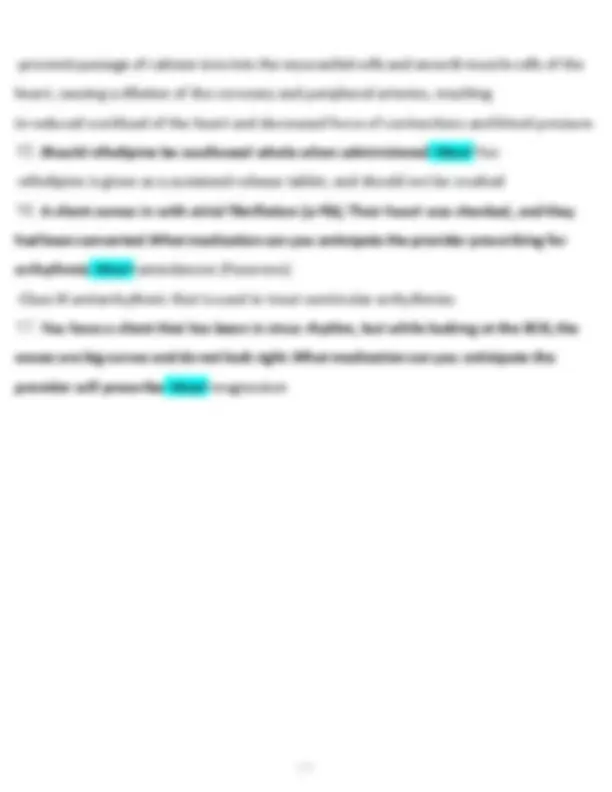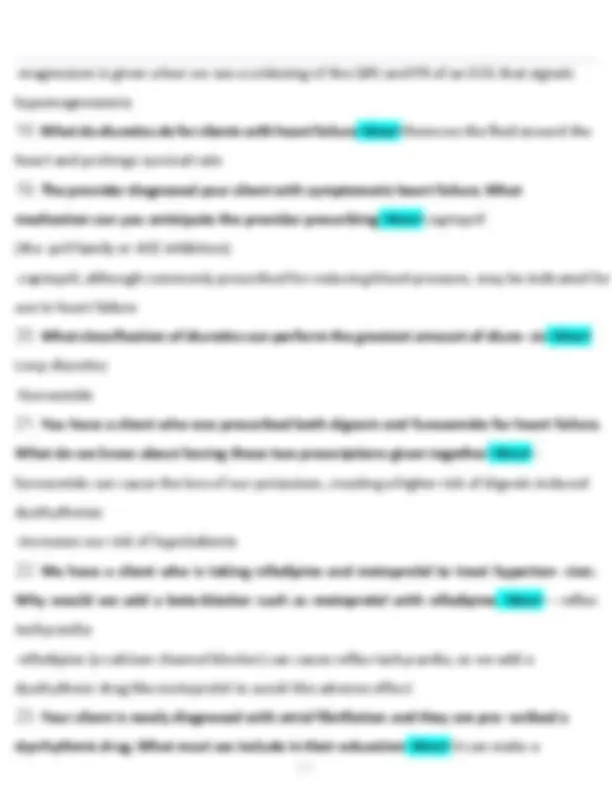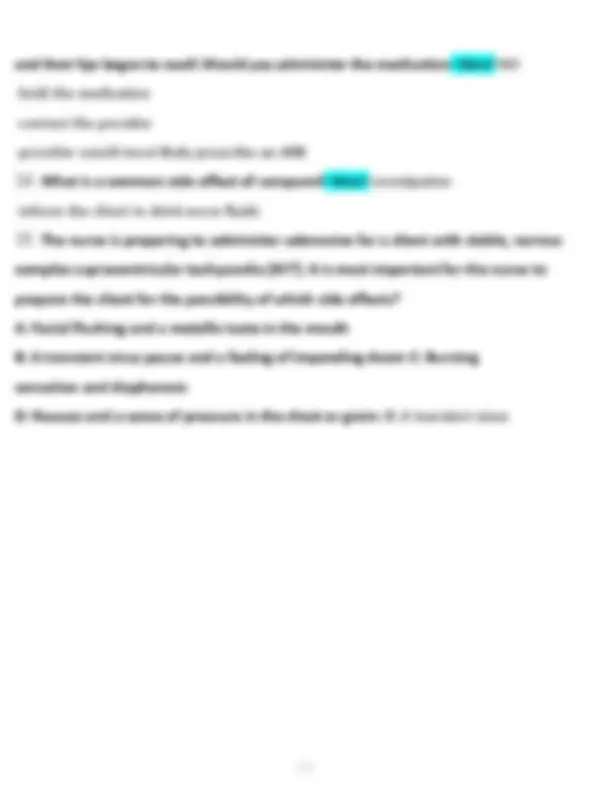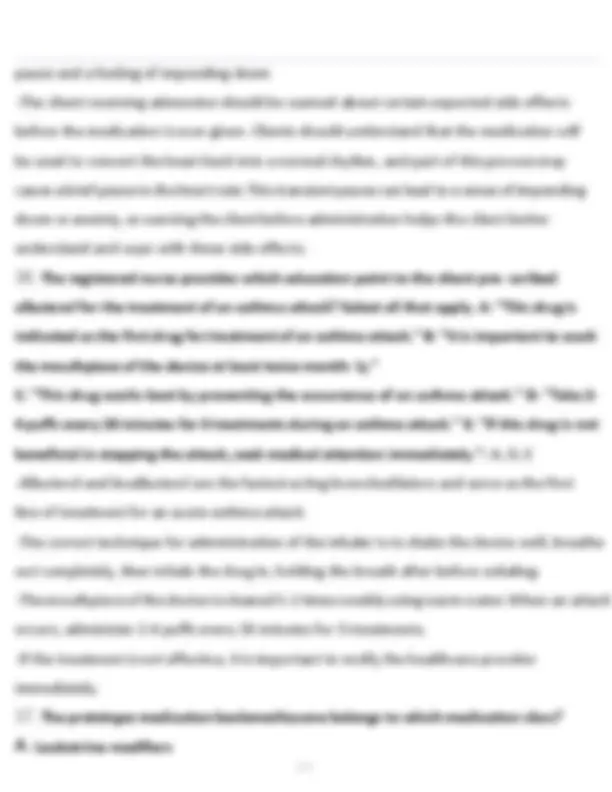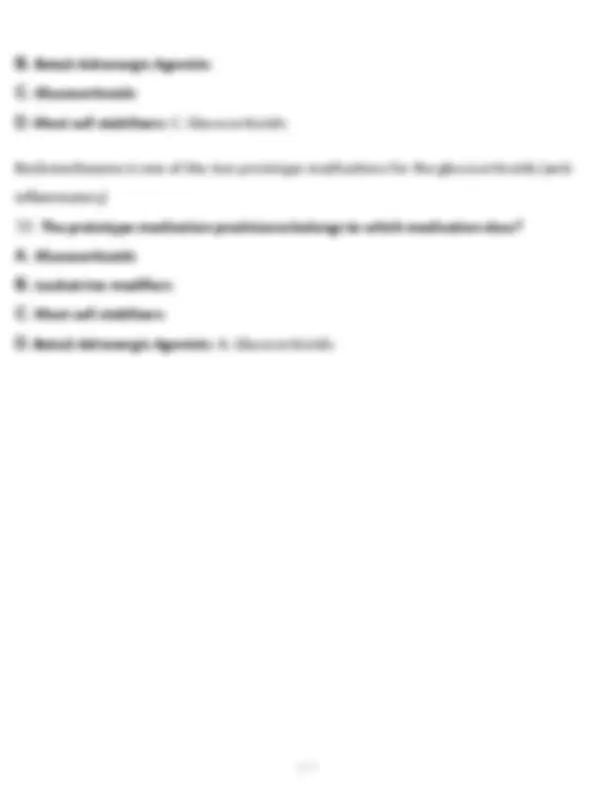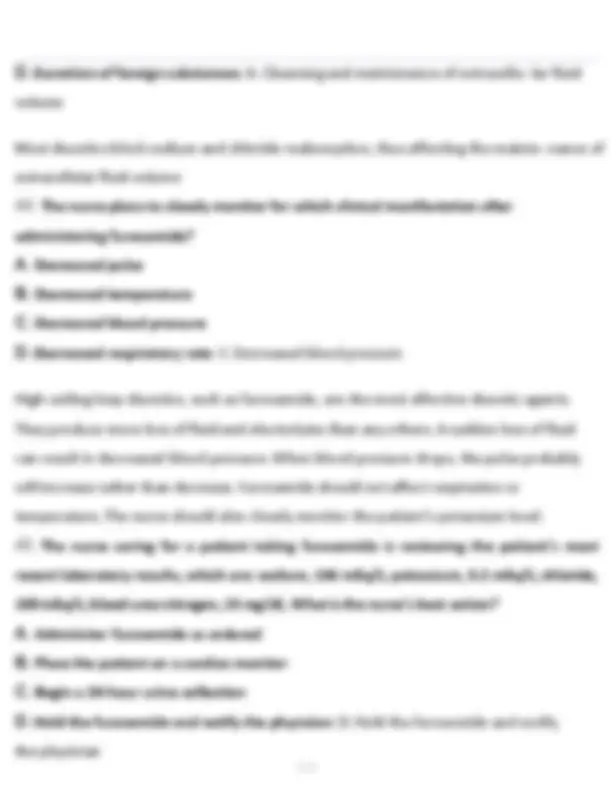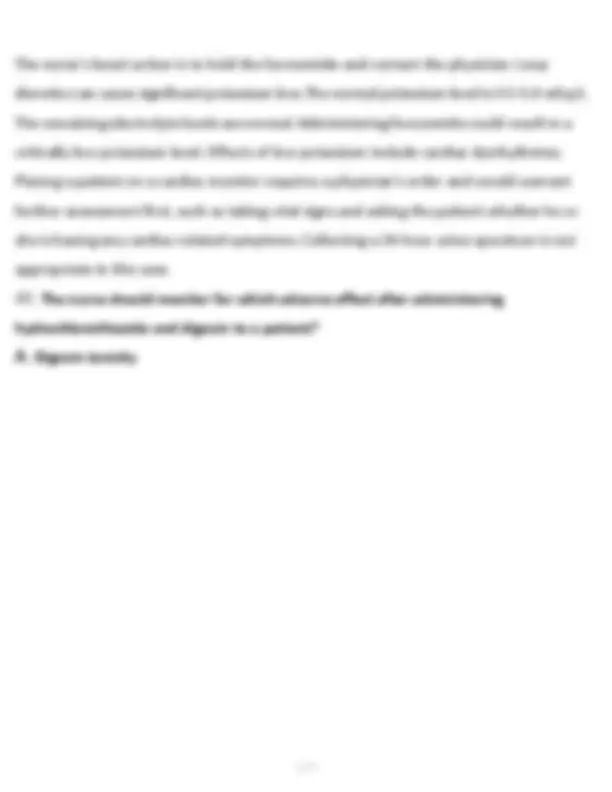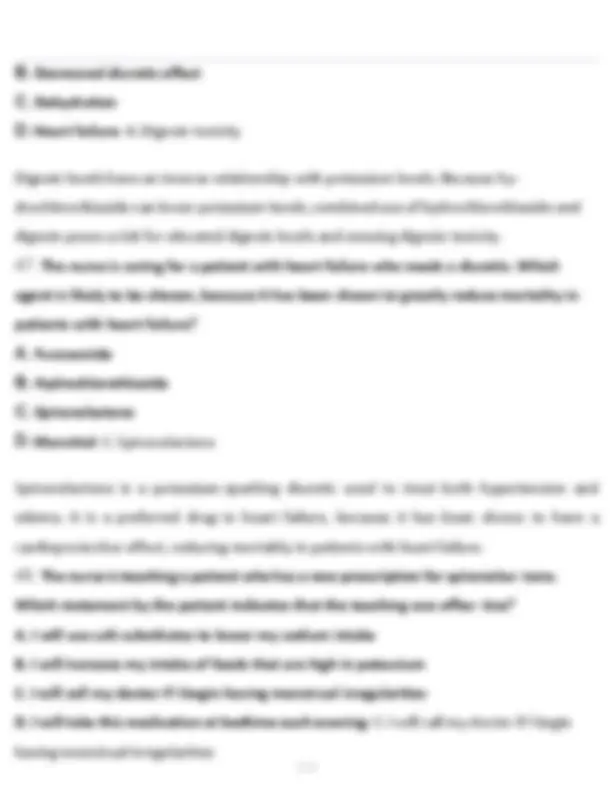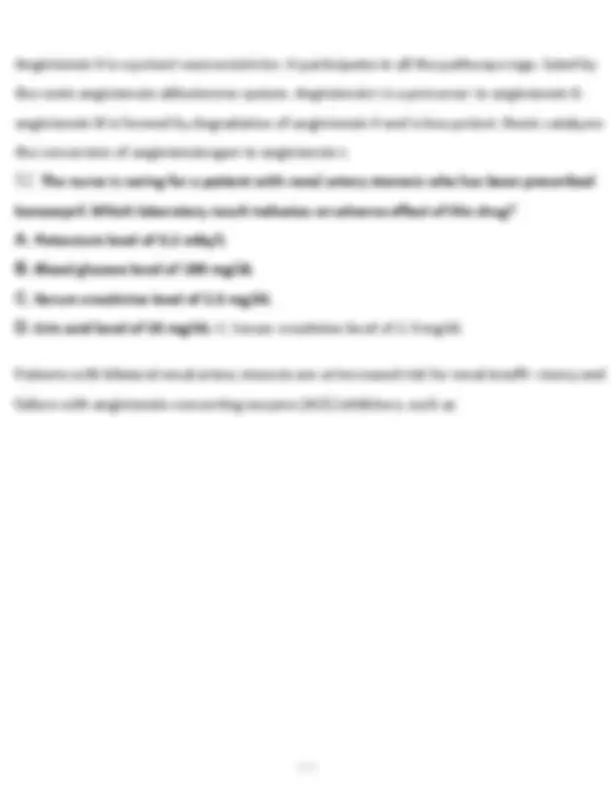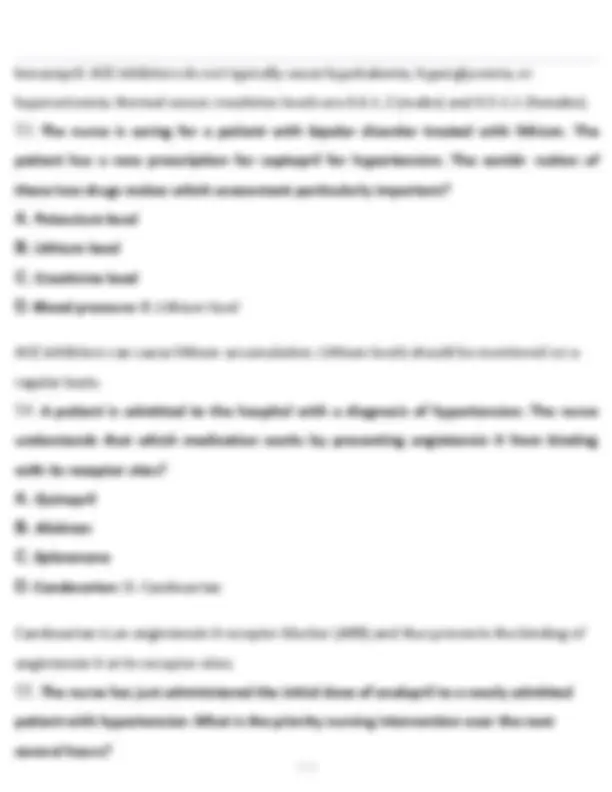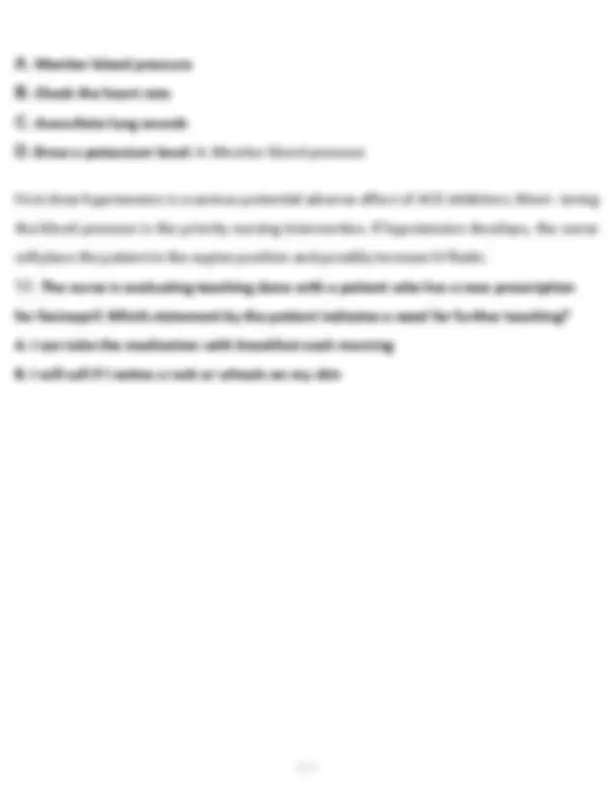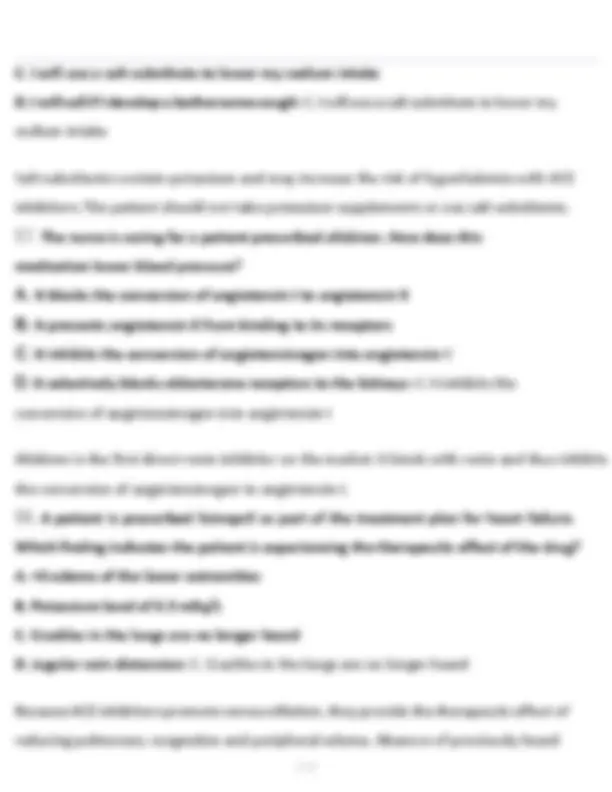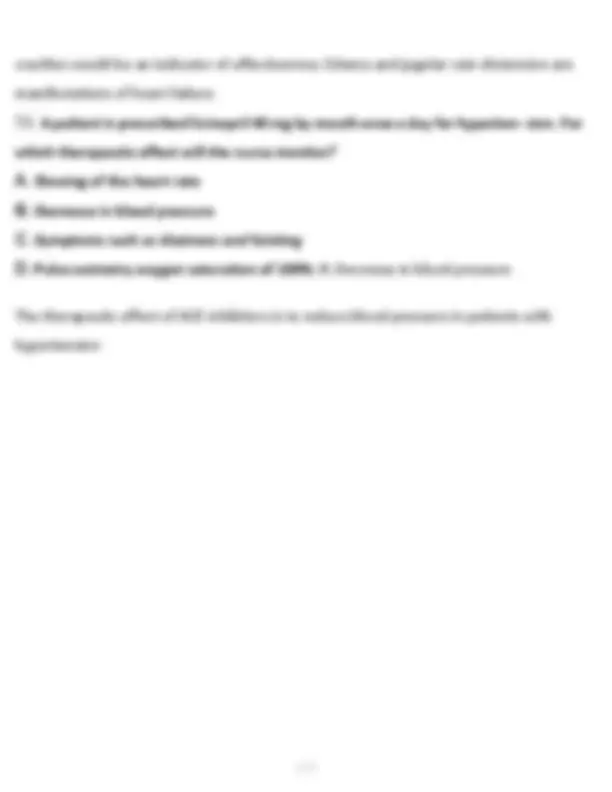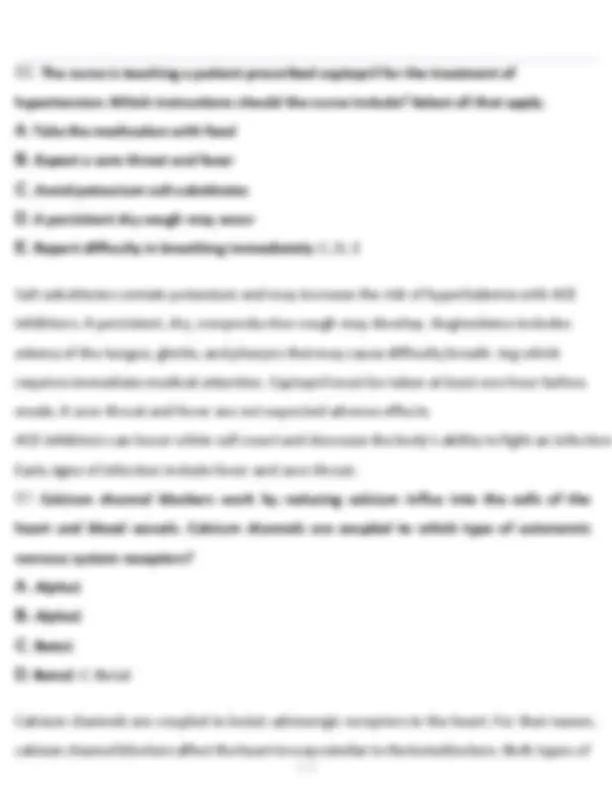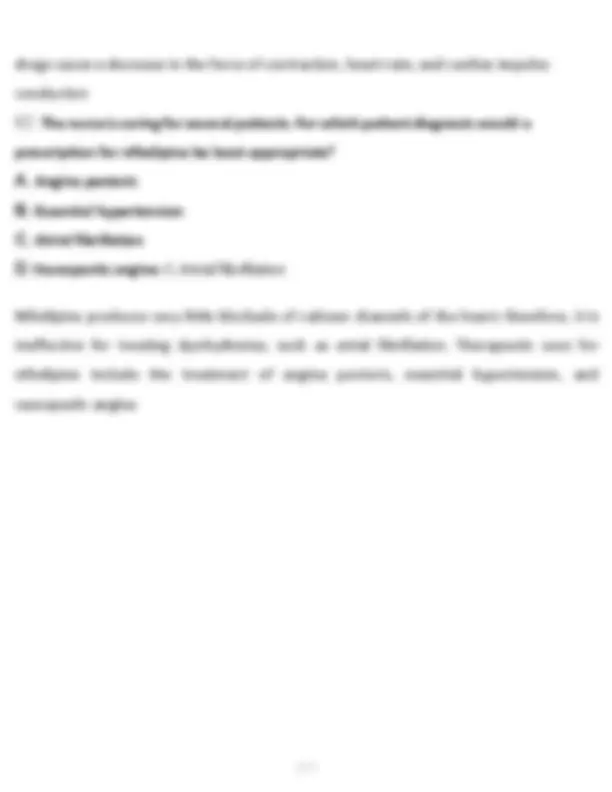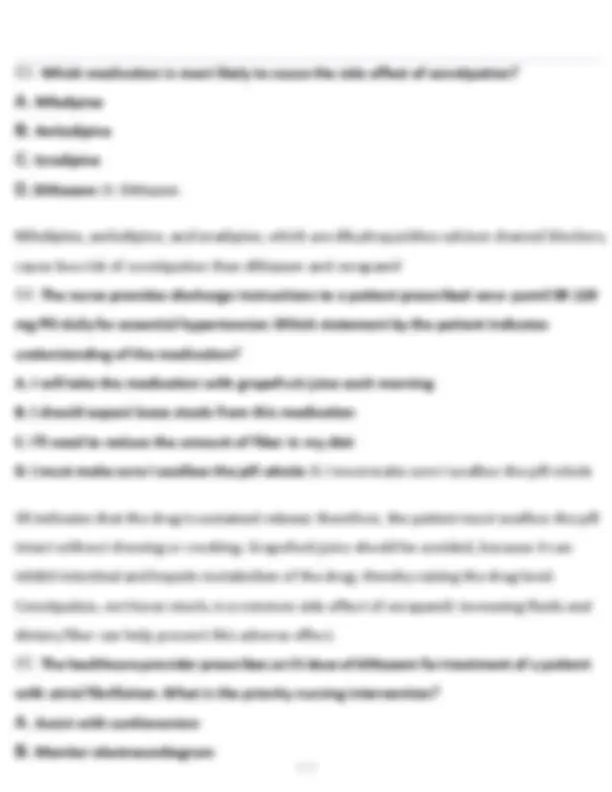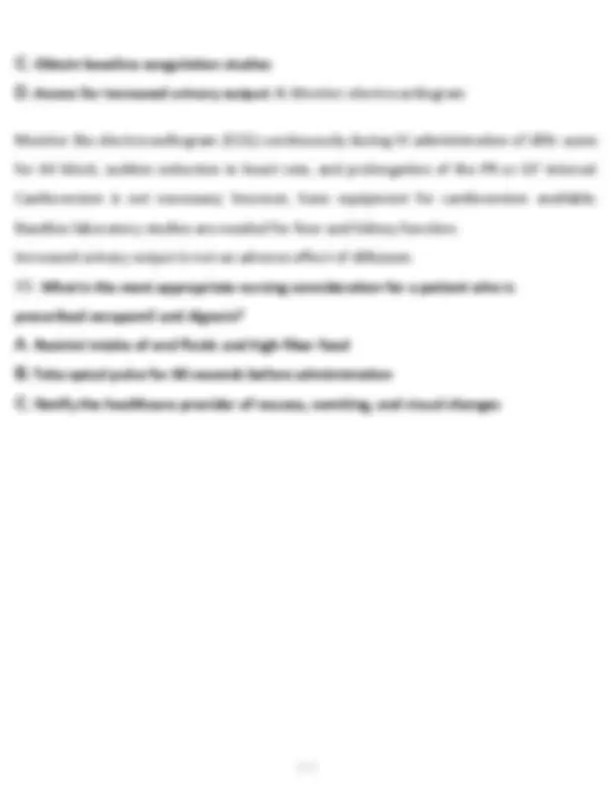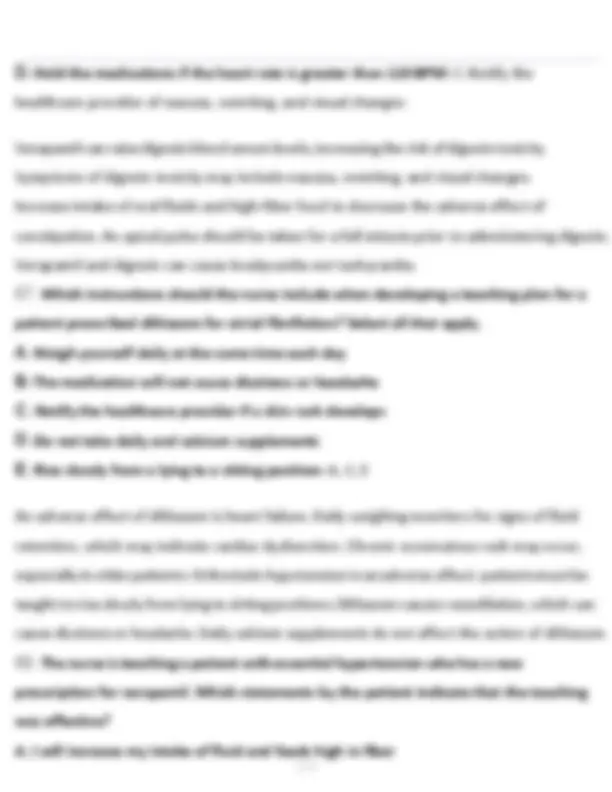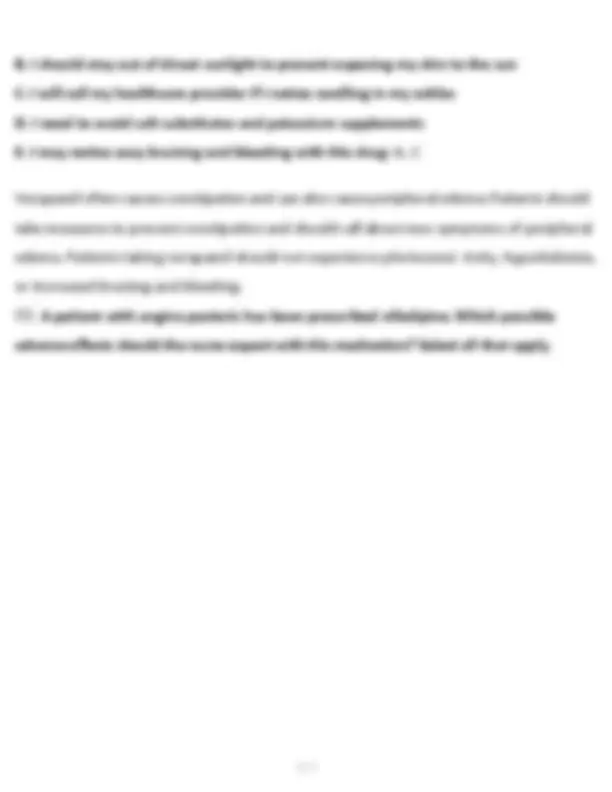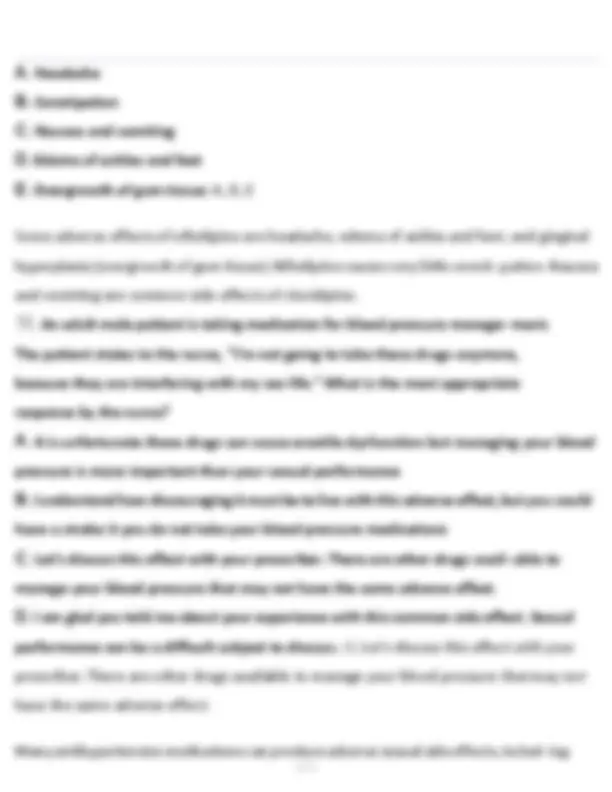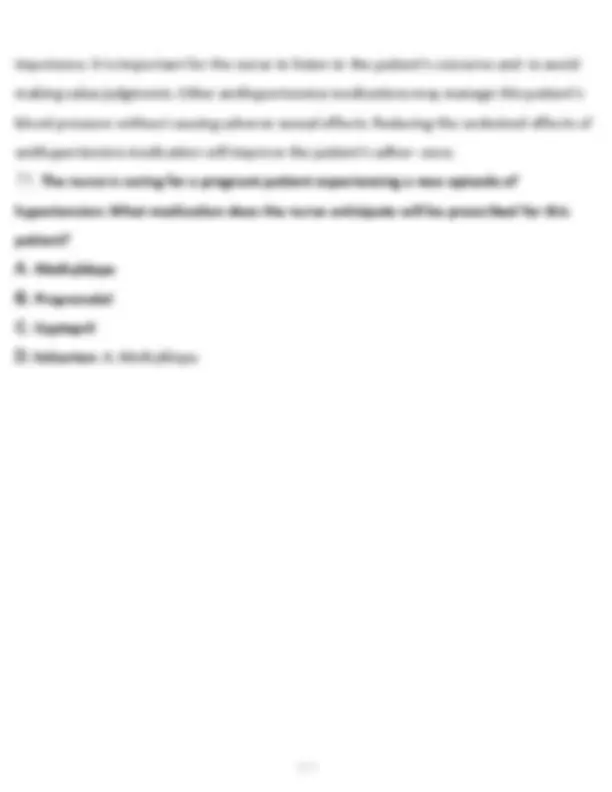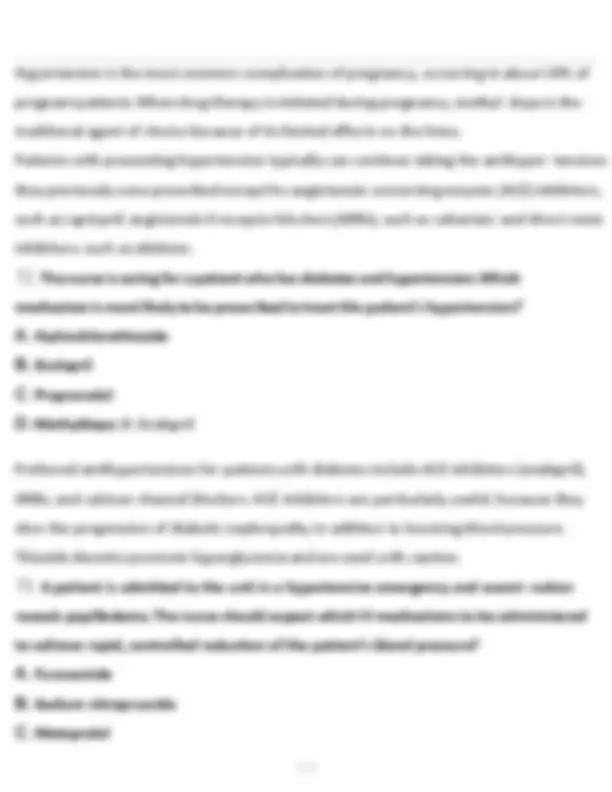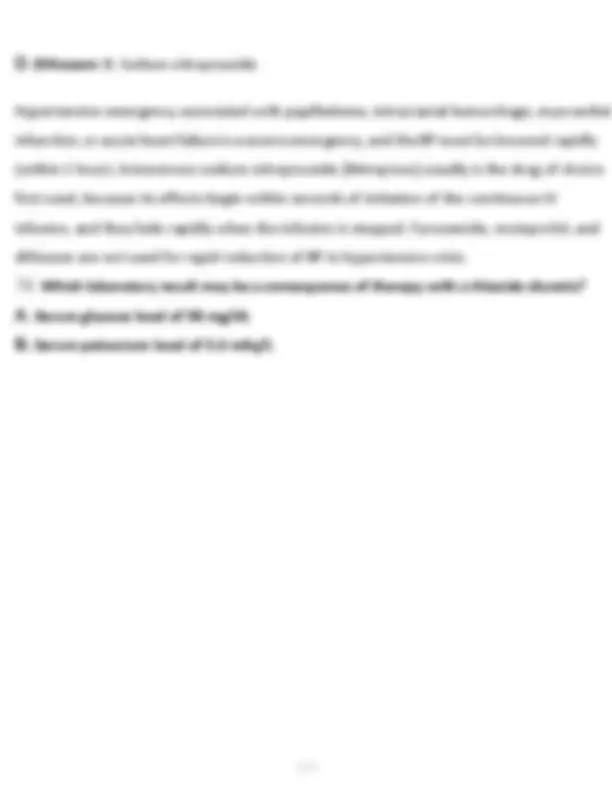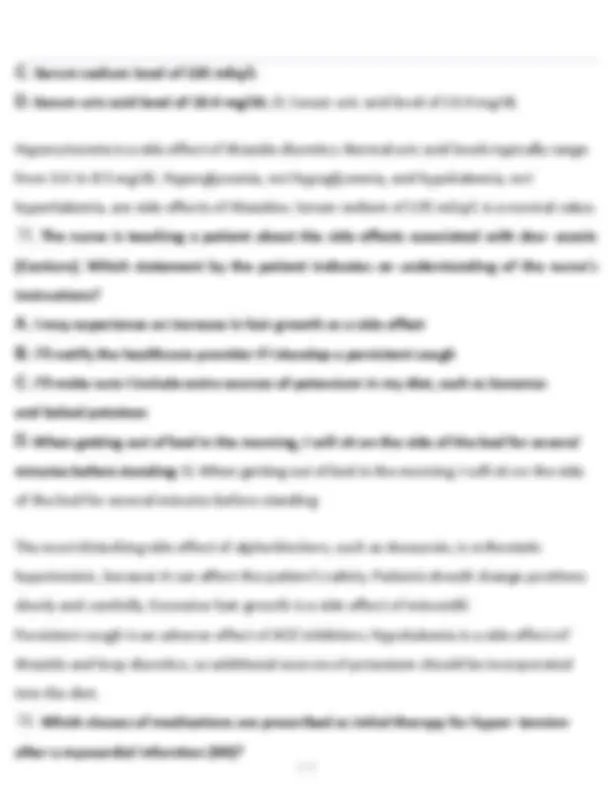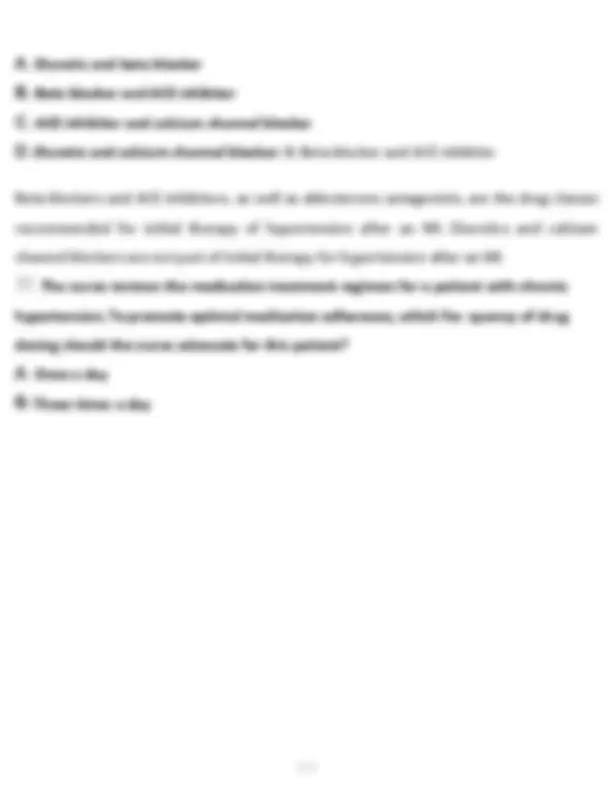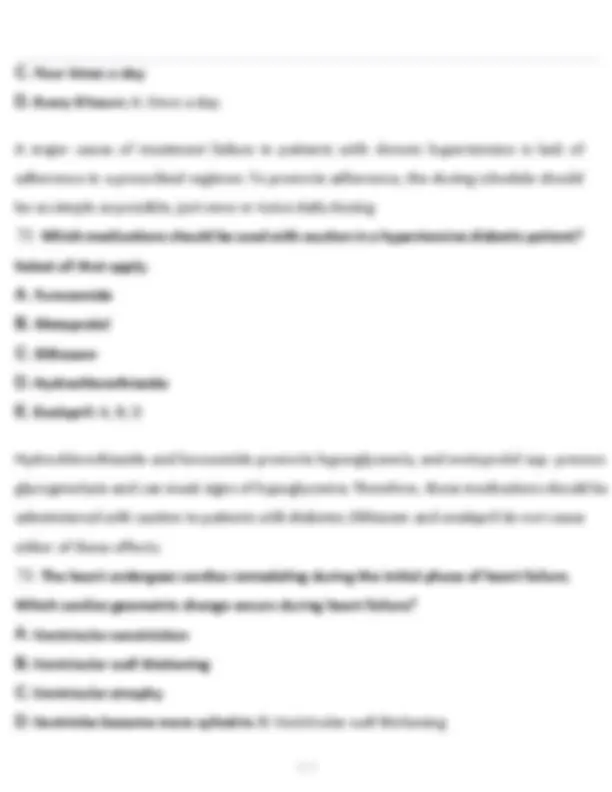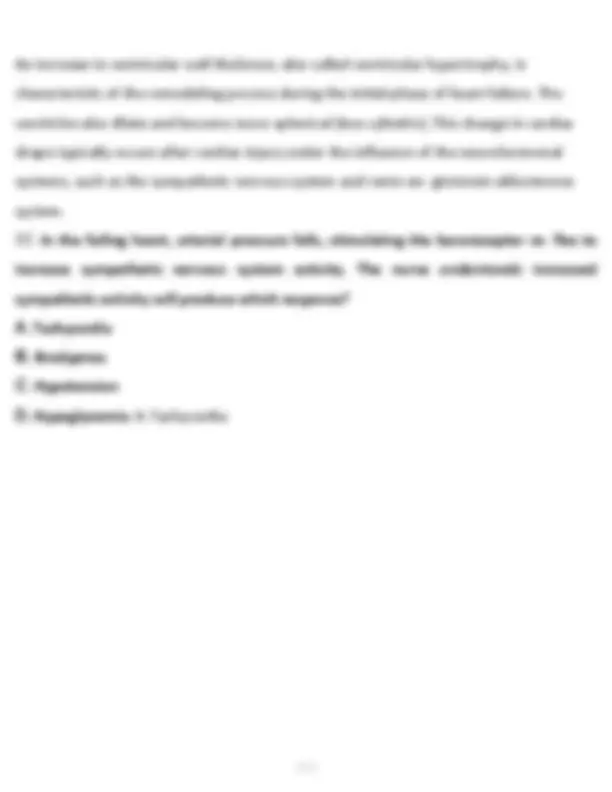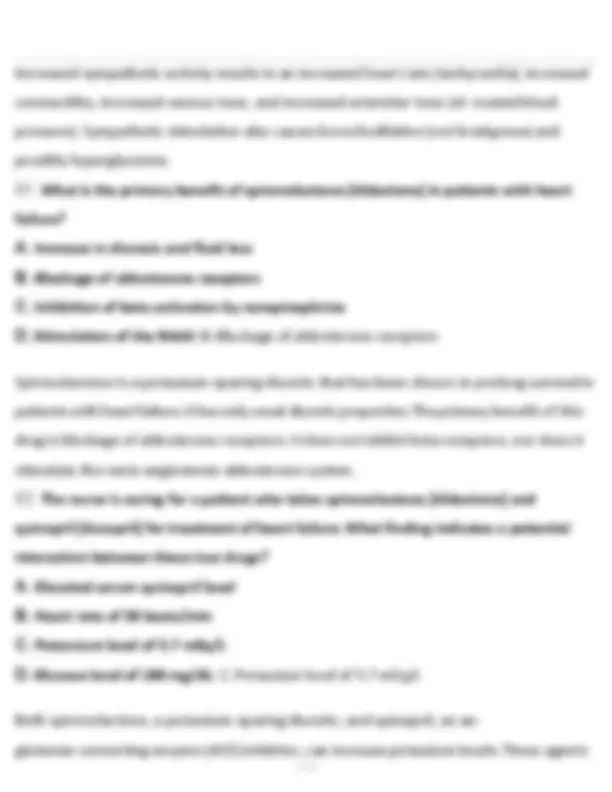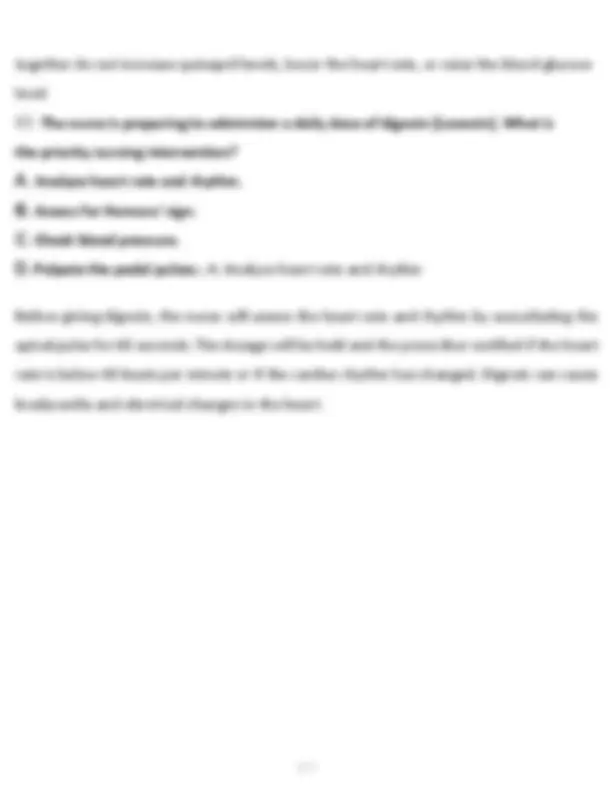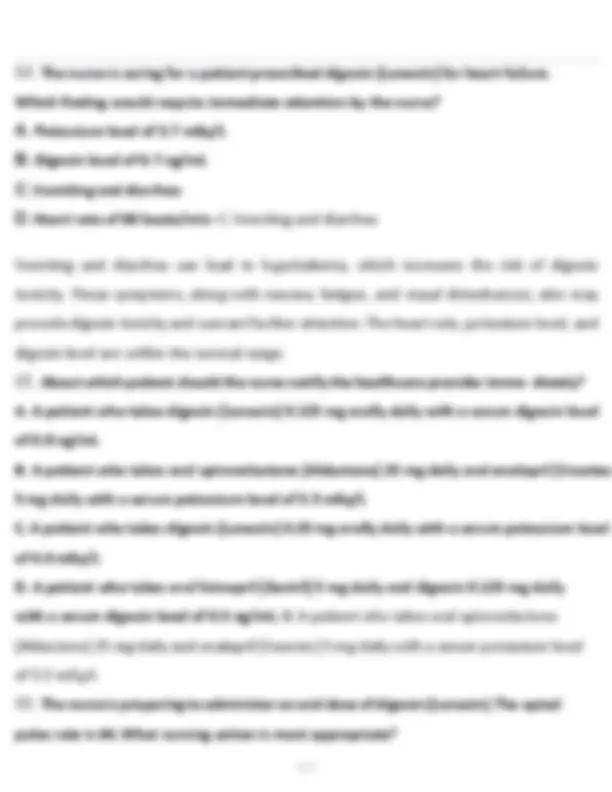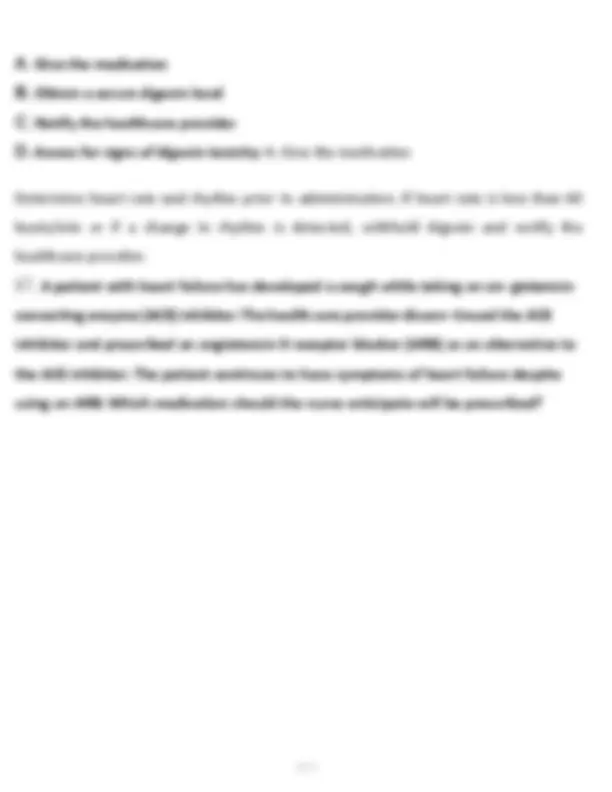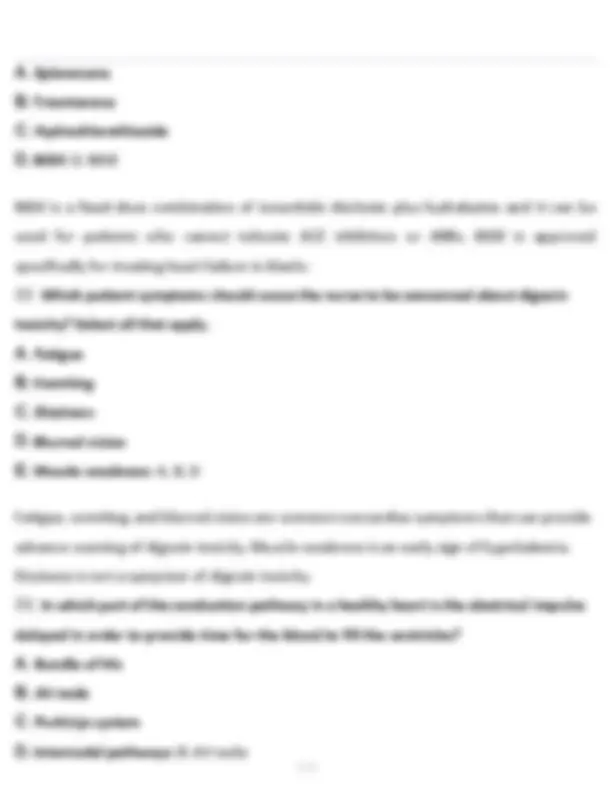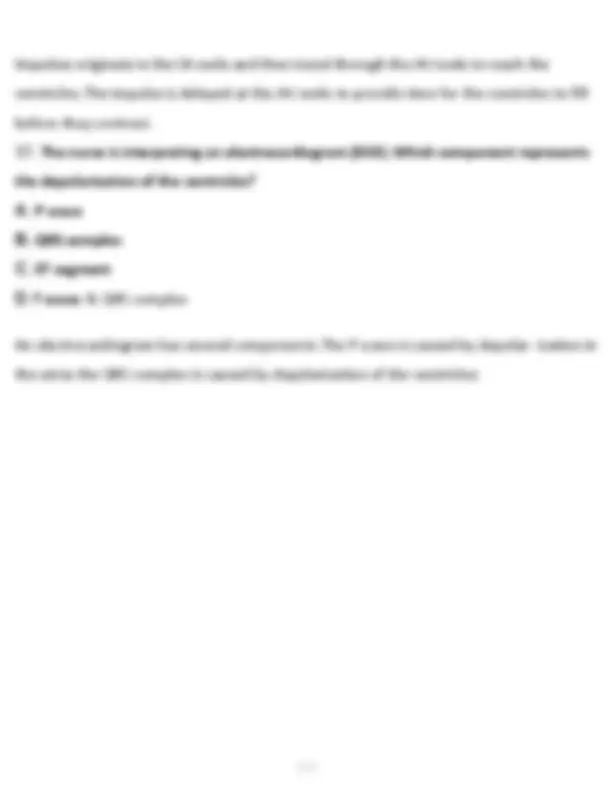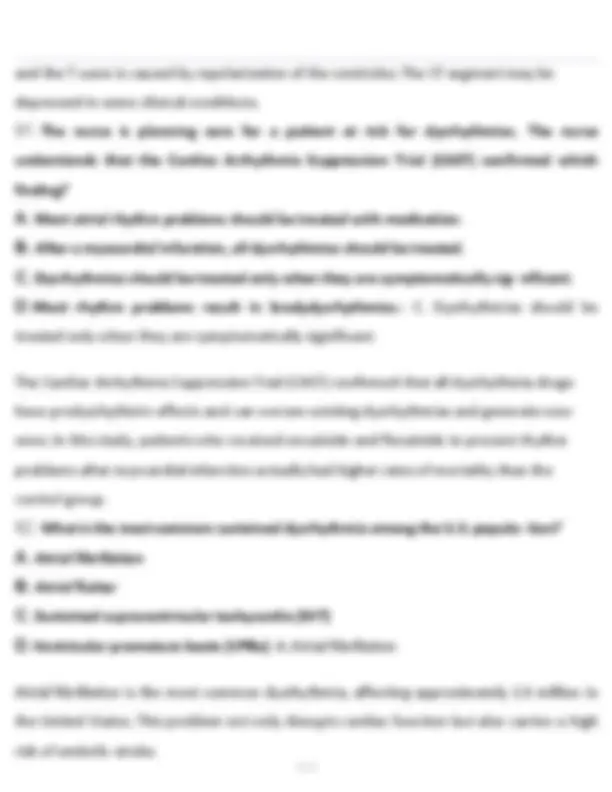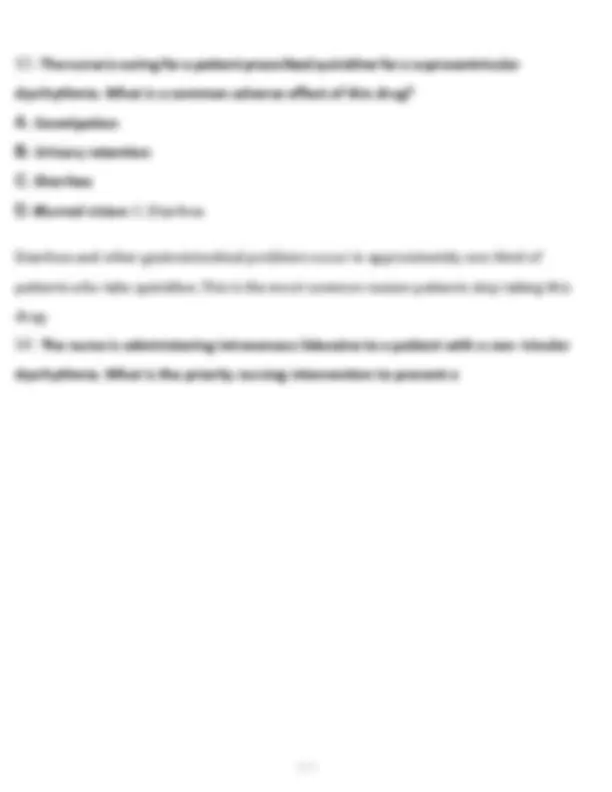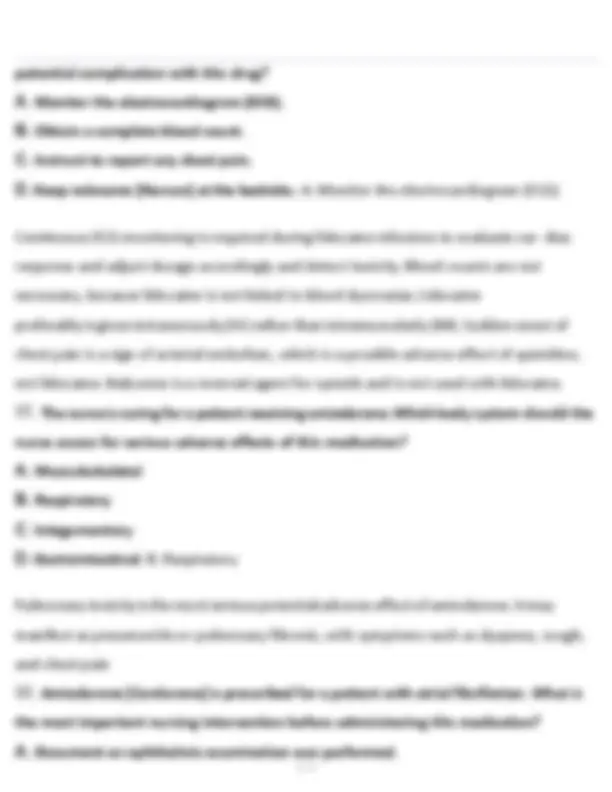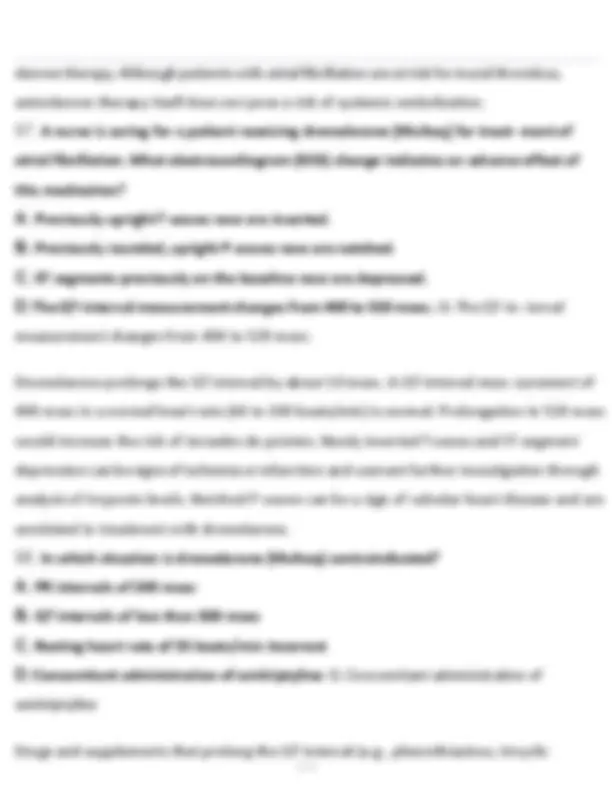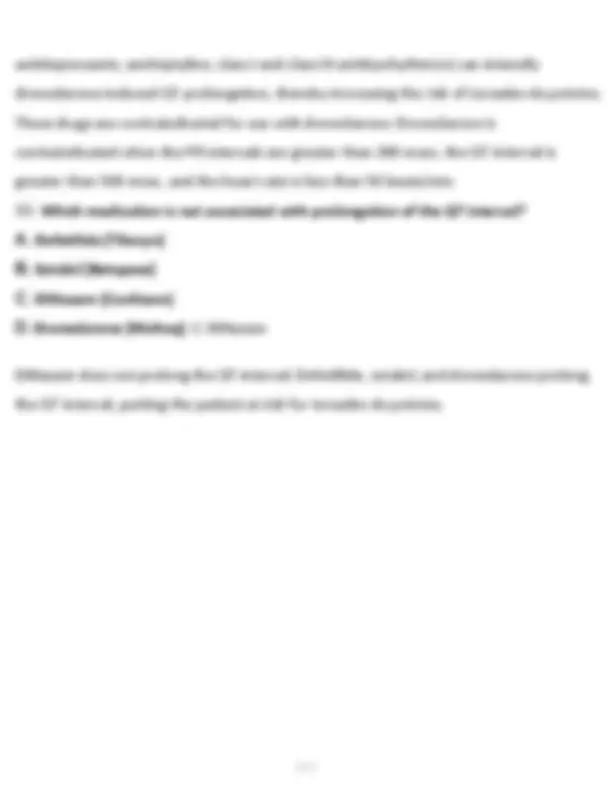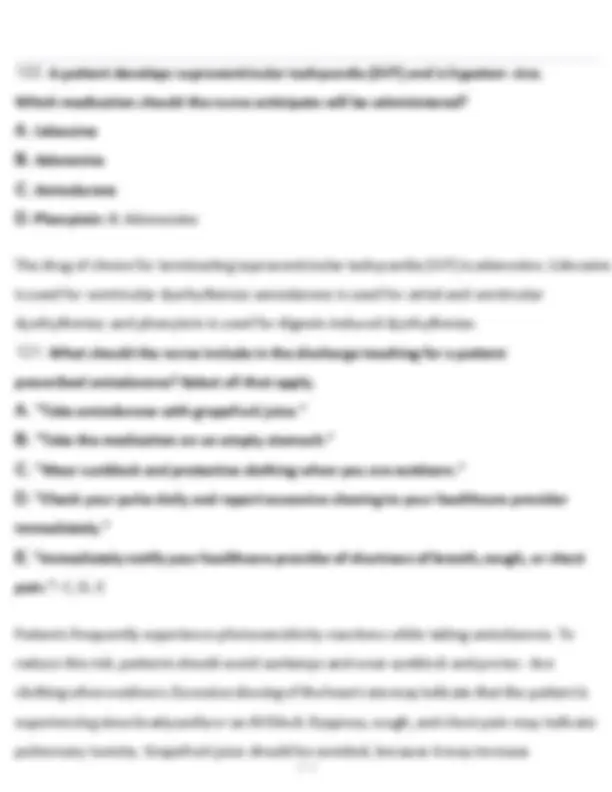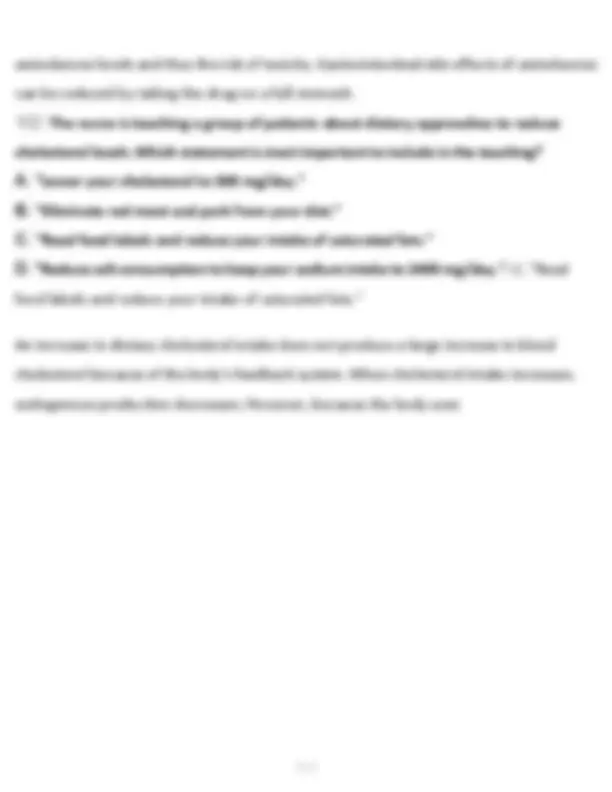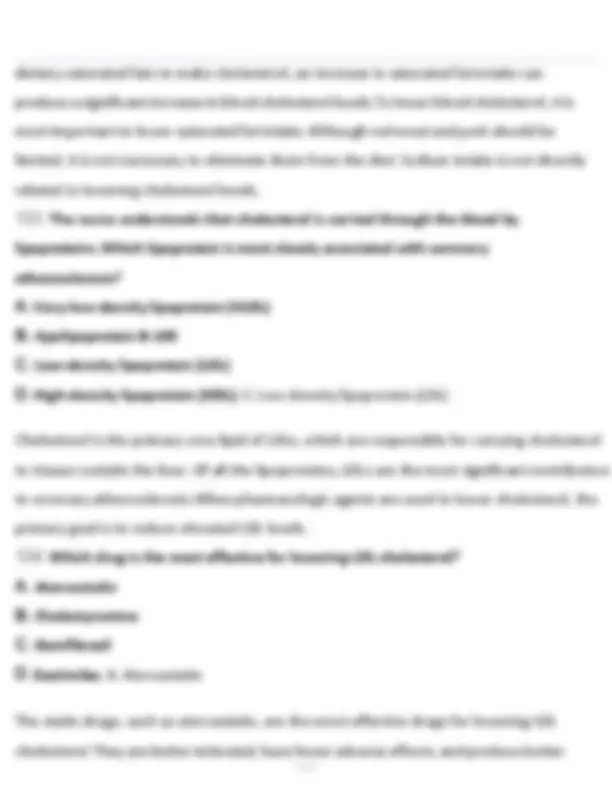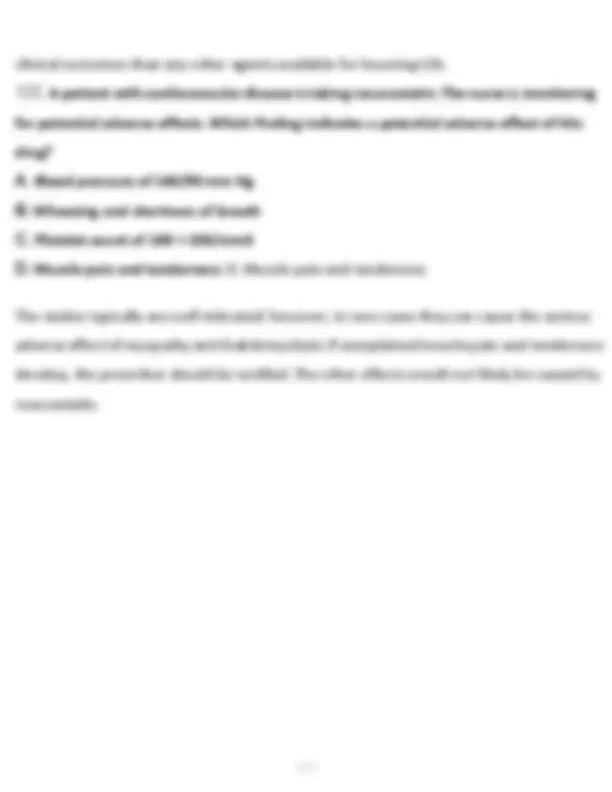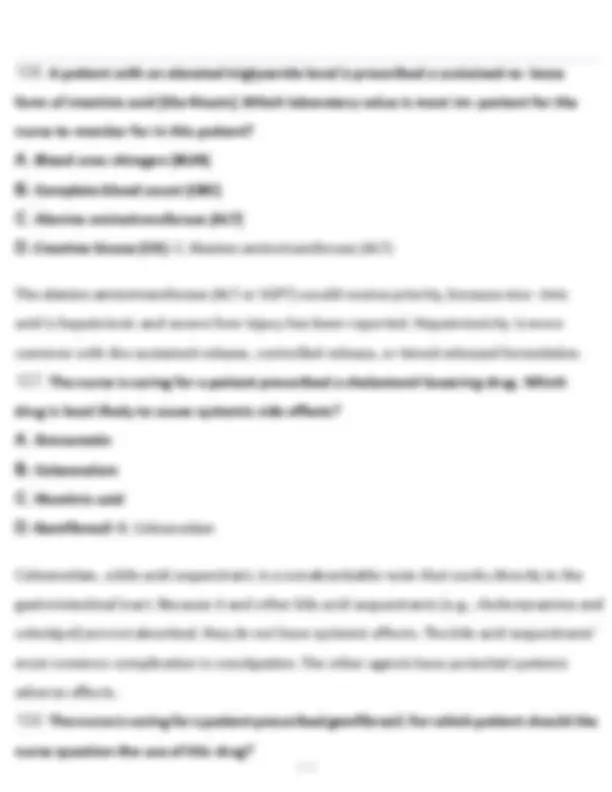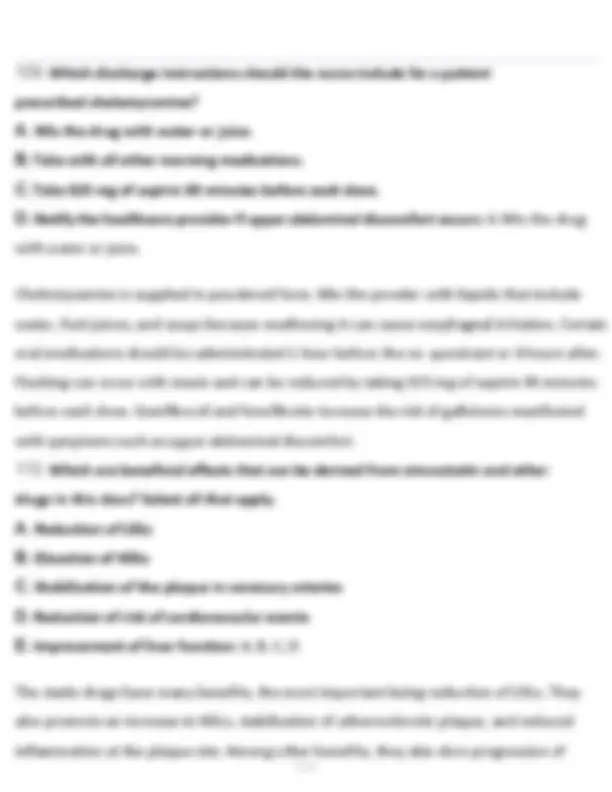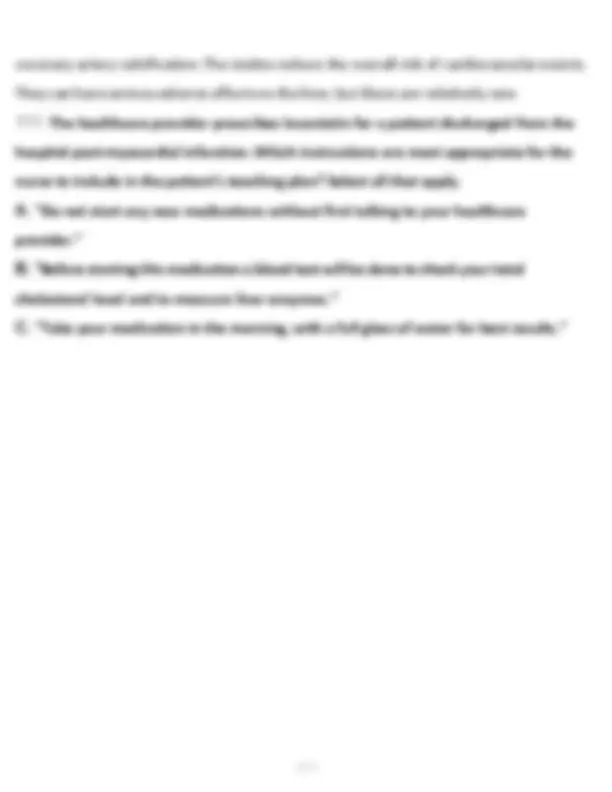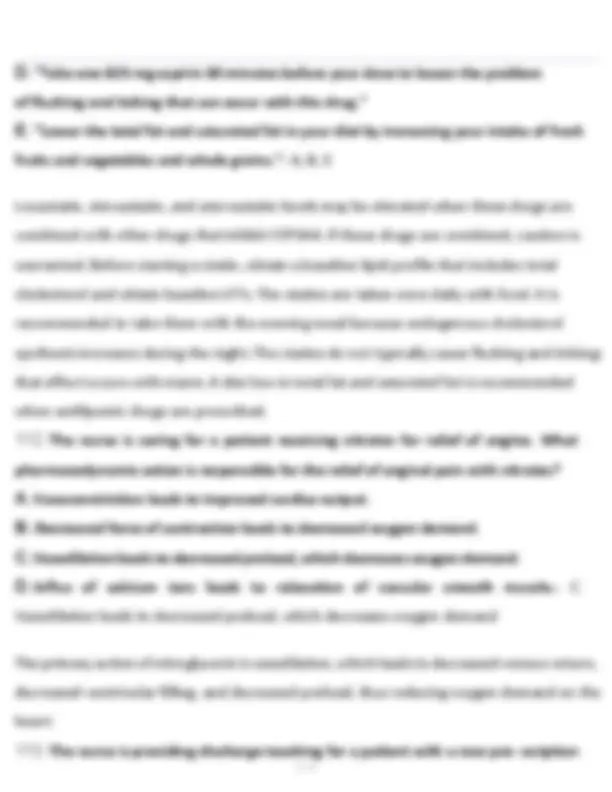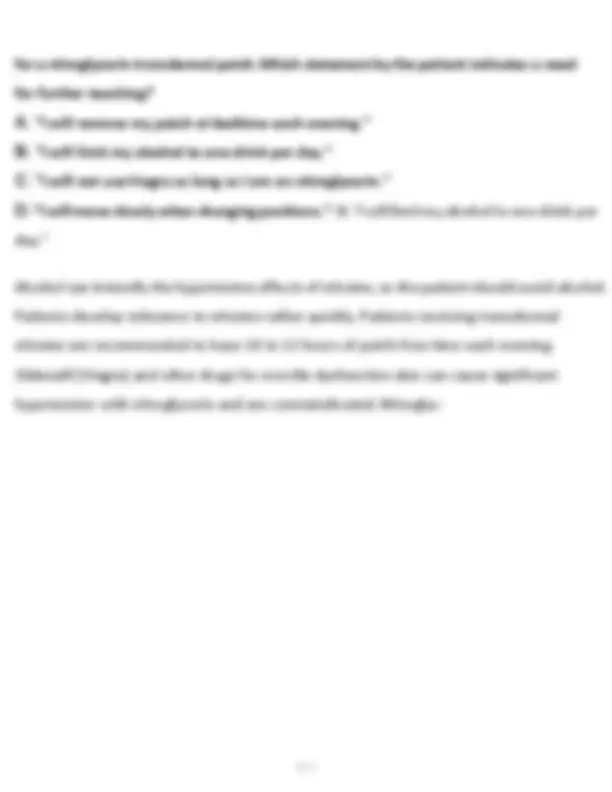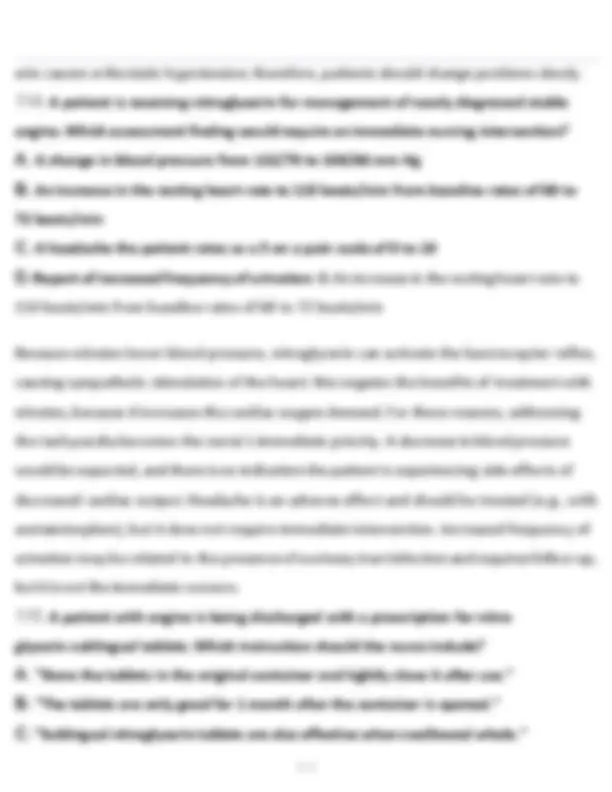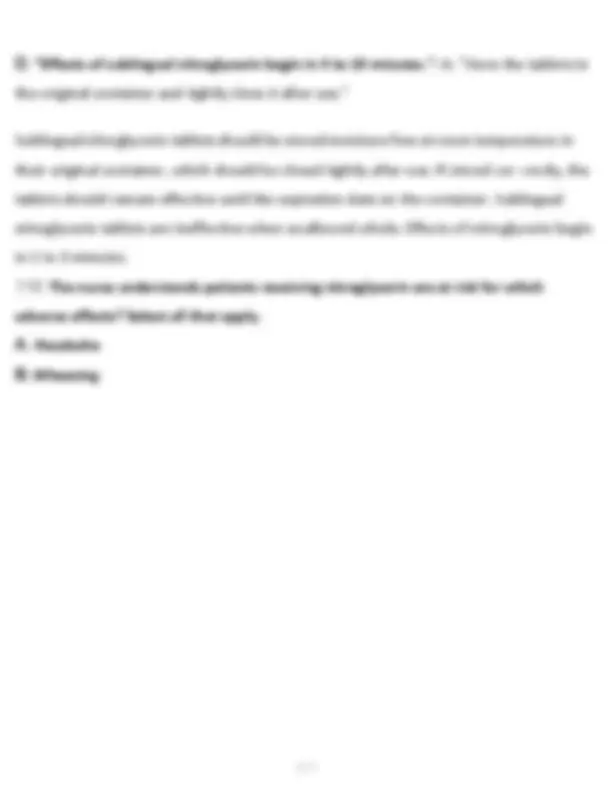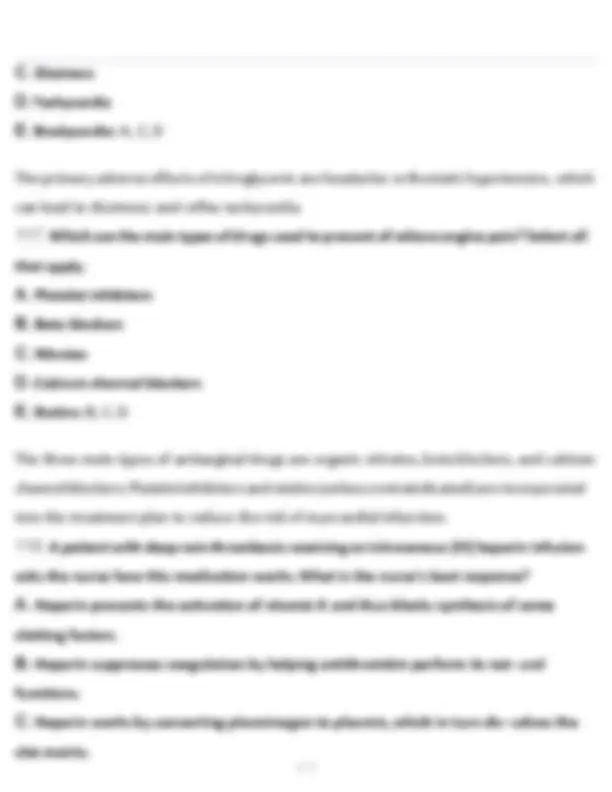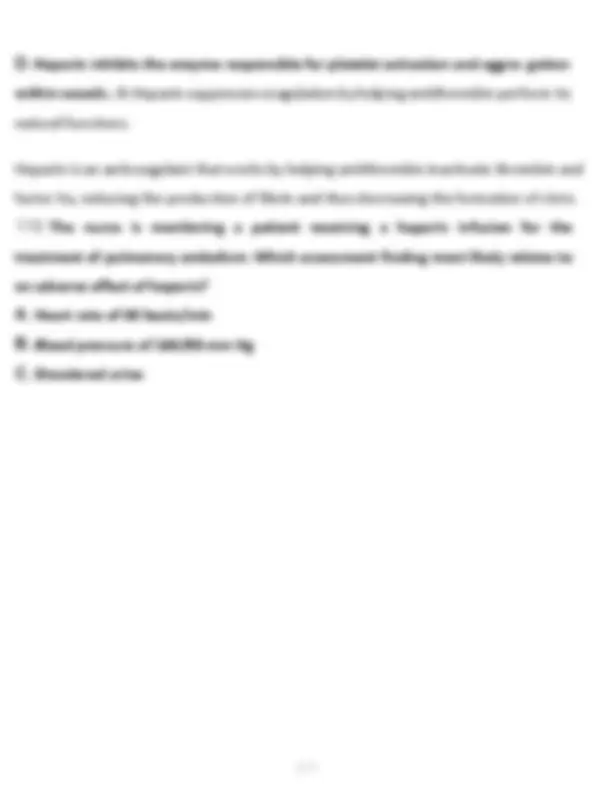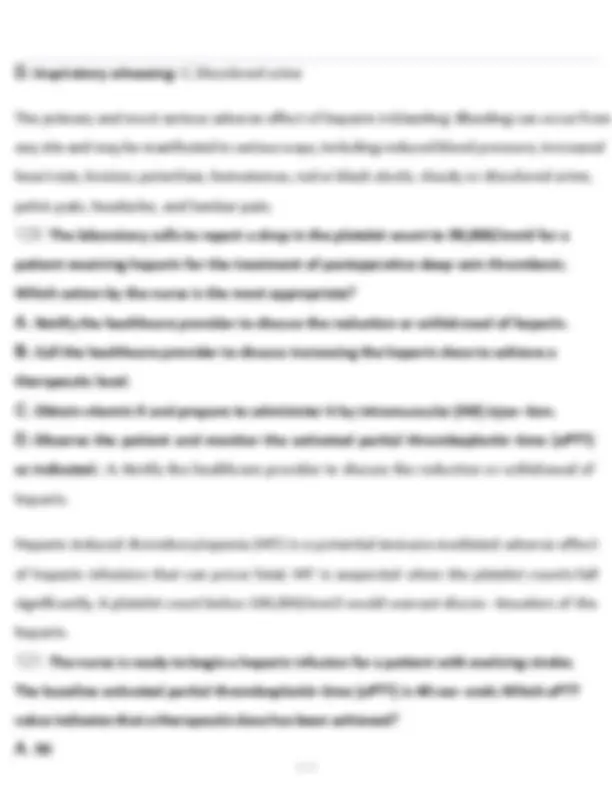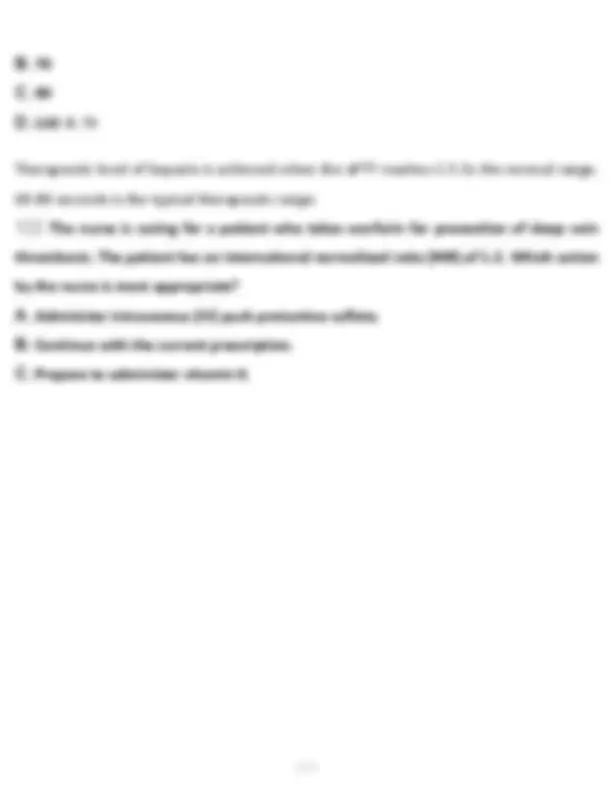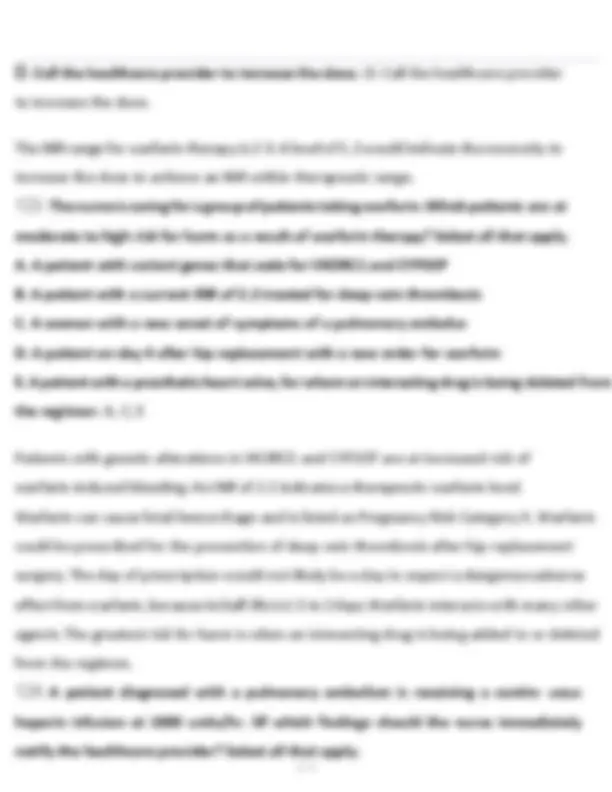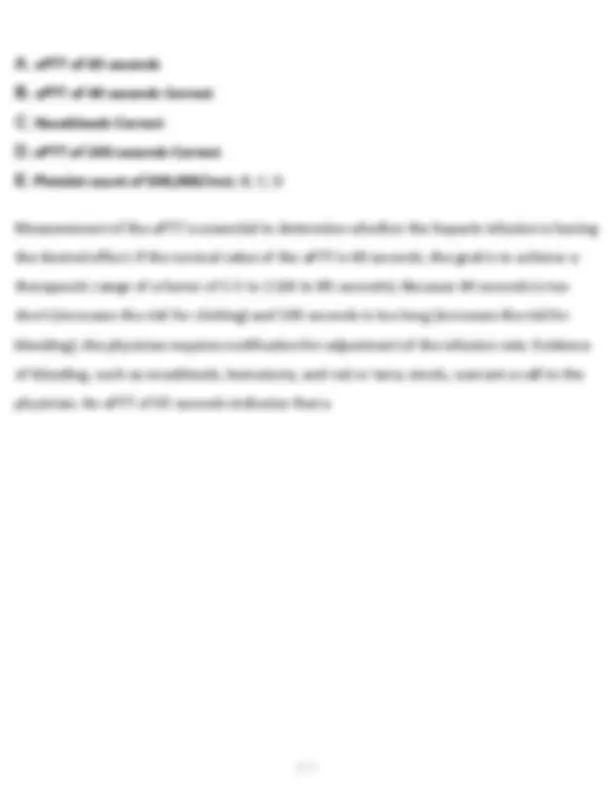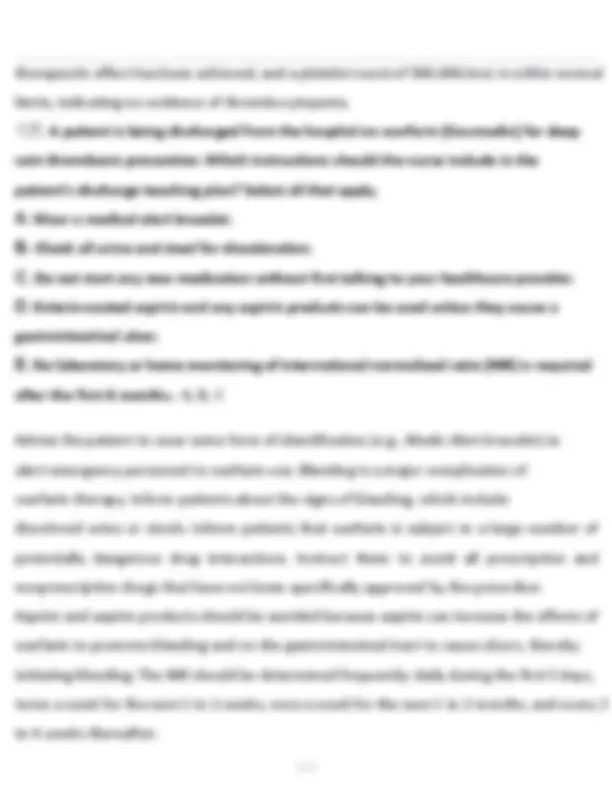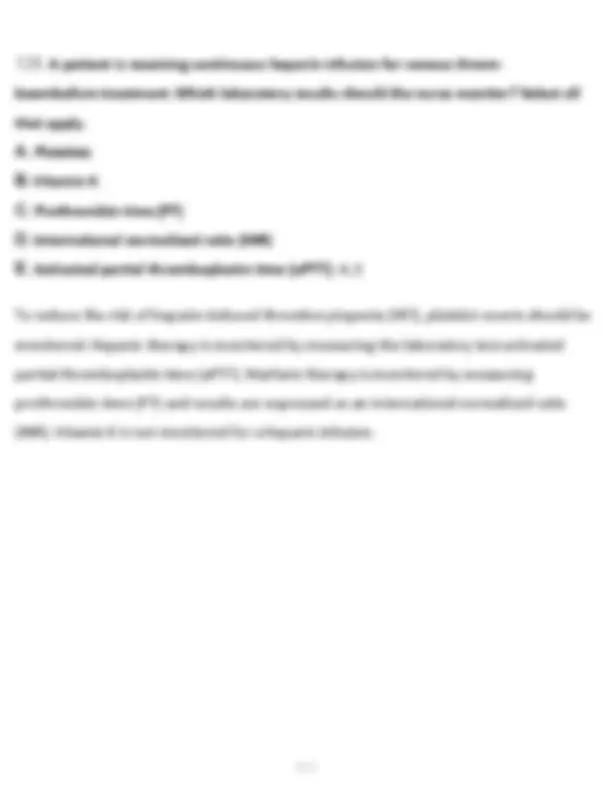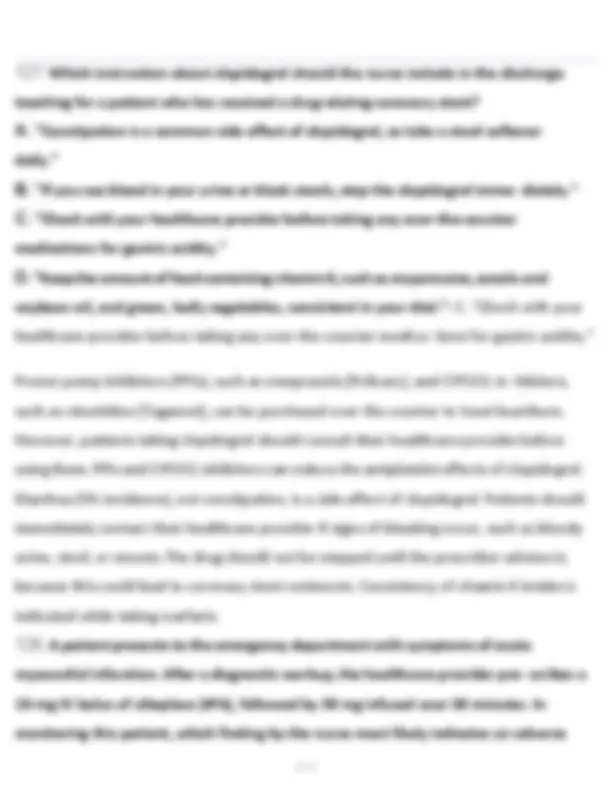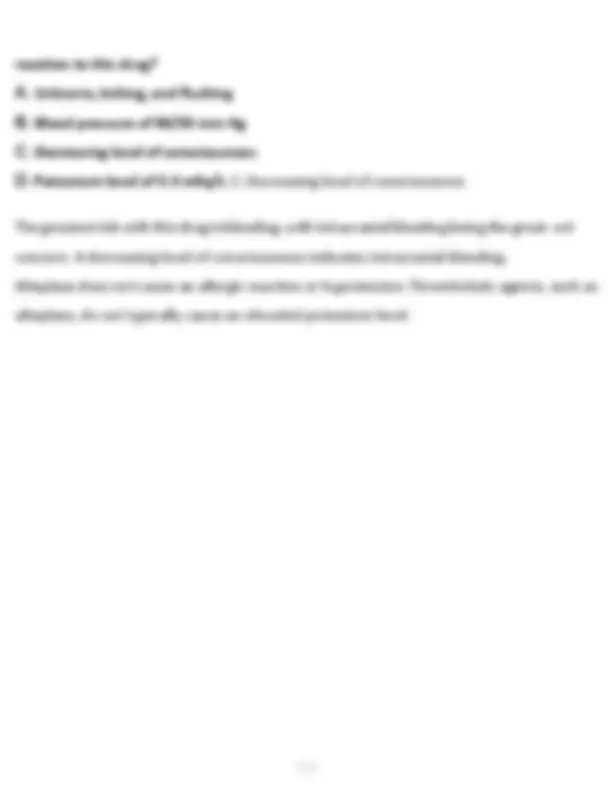Download Pharmacology Exam 2: Questions and Answers and more Exams Marketing Business-to-business (B2B) in PDF only on Docsity!
Rasmussen Pharmacology Exam 2
- What is the therapeutic level for digoxin 0.5-0.8 ng/mL
- The lab results indicate that the serum value for digoxin is 0.4 ng/mL. What can we anticipate that the provider will do Increase the dosage
- You are going to discharge your client and you notice that the provider has prescribed both cimetidine and an antacid. What kind of teaching do you have to provide for this client prior to discharge -Do not take them together. -Take the antacid 1 hour after the cimetidine.
- True or False: Your client has been prescribed beclomethasone and al- buterol. After patient education, the client states "I will take 2 puffs of my beclomethasone only when I'm wheezing.": False The client should take the albuterol first if they are experiencing wheezing.
- What teaching is appropriate for clients prescribed inhalers -Rinse your mouth after use. -1 minute between puffs. -Inhale and hold your breath. -Shake before use. -Prime your inhaler. -Use a spacer with the inhaler to get more of the medication into your lungs.
- What is H. pylori It is a bacteria found mostly in our stomach that is thought to be the major causative factor of peptic ulcer formation and gastritis.
- What medications treat H. pylori Antibiotics
- amoxicillin
- clarithromycin
- tetracycline
- Your client has been prescribed metronidazole to treat an H. pylori infection. What would be important information that they would need to know when taking this medication -Do not consume alcohol while taking this medication -Do not consume alcohol until 2-3 days after taking this medication -Consumption of alcohol while taking metronidazole can result in a severe reaction (nausea, vomiting, headache, cramps, flushing).
- Your client went to the provider with occasional constipation. The provider recommended a bulk-forming laxative. What do we need to educate the client on -Take with a full glass of water -Increase fiber intake
- (^) Your client with COPD is taking a glucocorticoid and a short-acting beta2-adrenergic agonist.Why would the provider have prescribed both med- ications -To open lungs and soothe inflammation
-prevents passage of calcium ions into the myocardial cells and smooth muscle cells of the heart, causing a dilation of the coronary and peripheral arteries, resulting in reduced workload of the heart and decreased force of contractions and blood pressure
- Should nifedipine be swallowed whole when administered Yes -nifedipine is given as a sustained-release tablet, and should not be crushed
- A client comes in with atrial fibrillation (a-fib). Their heart was shocked, and they had been converted.What medication can you anticipate the provider prescribing for arrhythmia amiodarone (Pacerone) -Class III antiarrhythmic that is used to treat ventricular arrhythmias
- You have a client that has been in sinus rhythm, but while looking at the ECG, the waves are big curves and do not look right.What medication can you anticipate the provider will prescribe magnesium
-magnesium is given when we see a widening of the QRS and PR of an ECG that signals hypomagnesemia
- What do diuretics do for clients with heart failure Removes the fluid around the heart and prolongs survival rate
- The provider diagnosed your client with symptomatic heart failure. What medication can you anticipate the provider prescribing captopril (the -pril family or ACE inhibitors) -captopril, although commonly prescribed for reducing blood pressure, may be indicated for use in heart failure
- What classification of diuretics can perform the greatest amount of diure- sis Loop diuretics
- You have a client who was prescribed both digoxin and furosemide for heart failure. What do we know about having these two prescriptions given together - furosemide can cause the loss of our potassium, creating a higher risk of digoxin-induced dysrhythmias -increases our risk of hypokalemia
- We have a client who is taking nifedipine and metoprolol to treat hyperten- sion. Why would we add a beta-blocker such as metoprolol with nifedipine - reflex tachycardia -nifedipine (a calcium channel blocker) can cause reflex tachycardia, so we add a dysrhythmic drug like metoprolol to avoid this adverse effect
- Your client is newly diagnosed with atrial fibrillation and they are pre- scribed a dysrhythmic drug. What must we include in their education it can make a
- Your client comes in with heart failure and has a potassium serum level of 2.8 and the provider has ordered the diuretic furosemide.Would you adminis- ter the drug NO -you would want to give a potassium-sparing diuretic like spironolactone
- Before administering hydrochlorothiazide, you see that the client's GFR is 17 mL/min. Would you administer the medication NO -The GFR is very low
- You have a client with high cholesterol who was started on atorvastatin and they come in with complaints of muscle pain, fatigue, and weakness.What labs would the provider order for the client creatinine (CK) levels, liver function tests, and kidneys -atorvastatin (Lipitor) are used primarily to reduce LDL cholesterol levels and to reduce total blood cholesterol levels
- If your client had a history of asthma and the provider has prescribed propranolol, would this be concerning YES -propranolol can induce respiratory depression
- What medications may we anticipate that a client with dysrhythmias would be prescribed -beta blockers -verapamil (calcium channel blocker) -diltiazem (calcium channel blocker)
- If the provider ordered lisinopril for a client with dysrhythmias, what client education would we provide -rise and reposition slowly
- You are preparing to administer captopril to your client when you check their allergies and see that they are allergic to enalapril. When asked what symptoms they had after taking enalapril, they said that their tongue swelled up, they could not talk,
and their lips began to swell.Would you administer the medication NO -hold the medication -contact the provider -provider would most likely prescribe an ARB
- What is a common side effect of verapamil constipation -inform the client to drink more fluids
- The nurse is preparing to administer adenosine for a client with stable, narrow complex supraventricular tachycardia (SVT). It is most important for the nurse to prepare the client for the possibility of which side effects? A: Facial flushing and a metallic taste in the mouth B: A transient sinus pause and a feeling of impending doom C: Burning sensation and diaphoresis D: Nausea and a sense of pressure in the chest or groin: B: A transient sinus
B. Beta2-Adrenergic Agonists C. Glucocorticoids D. Mast cell stabilizers: C. Glucocorticoids Beclomethasone is one of the two prototype medications for the glucocorticoids (anti- inflammatory)
- The prototype medication prednisone belongs to which medication class? A. Glucocorticoids B. Leukotrine modifiers C. Mast cell stabilizers D. Beta2-Adrenergic Agonists: A. Glucocorticoids
Prednisone is one of the two prototype medications for the glucocorticoids (anti-in- flammatory)
- The prototype medication cromolyn belongs to which medication class? A. Glucocorticoids B. Leukotrine modifiers C. Mast cell stabilizers D. Beta2-Adrenergic Agonists: C. Mast cell stabilizer Cromolyn is the prototype medication for the mast cell stabilizers (anti-inflammatory)
- The prototype medication zafirlukast belongs to which medication class? A. Glucocorticoids B. Leukotrine modifiers C. Mast cell stabilizers D. Beta2-Adrenergic Agonists: B. Leukotrine modifiers Zafirlukast is the prototype medication for the leukotrine receptor modifiers (anti-in- flammatory)
- The prototype medication albuterol belongs to which medication class? A. Glucocorticoids B. Leukotrine modifiers C. Mast cell stabilizers D. Beta2-Adrenergic Agonists: D. Beta2-Adrenergic Agonists Albuterol is the prototype medication for the short-acting beta agonist of the
D. Excretion of foreign substances: A. Cleansing and maintenance of extracellu- lar fluid volume Most diuretics block sodium and chloride reabsorption, thus affecting the mainte- nance of extracellular fluid volume
- The nurse plans to closely monitor for which clinical manifestation after administering furosemide? A. Decreased pulse B. Decreased temperature C. Decreased blood pressure D. Decreased respiratory rate: C. Decreased blood pressure High-ceiling loop diuretics, such as furosemide, are the most effective diuretic agents. They produce more loss of fluid and electrolytes than any others. A sudden loss of fluid can result in decreased blood pressure. When blood pressure drops, the pulse probably will increase rather than decrease. Furosemide should not affect respiration or temperature. The nurse should also closely monitor the patient's potassium level.
- The nurse caring for a patient taking furosemide is reviewing the patient's most recent laboratory results, which are: sodium, 136 mEq/L; potassium, 3.2 mEq/L; chloride, 100 mEq/L; blood urea nitrogen, 15 mg/dL. What is the nurse's best action? A. Administer furosemide as ordered B. Place the patient on a cardiac monitor C. Begin a 24-hour urine collection D. Hold the furosemide and notify the physician: D. Hold the furosemide and notify the physician
The nurse's beset action is to hold the furosemide and contact the physician. Loop diuretics can cause significant potassium loss.The normal potassium level is 3.5-5.0 mEq/L. The remaining electrolyte levels are normal. Administering furosemide could result in a critically low potassium level. Effects of low potassium include cardiac dysrhythmias. Placing a patient on a cardiac monitor requires a physician's order and would warrant further assessment first, such as taking vital signs and asking the patient whether he or she is having any cardiac-related symptoms. Collecting a 24-hour urine specimen is not appropriate in this case.
- The nurse should monitor for which adverse effect after administering hydrochlorothiazide and digoxin to a patient? A. Digoxin toxicity
Spironolactone is a potassium-sparing, aldosterone-blocking diuretic.As such, it can cause endocrine effects, such as gynecomastia, menstrual irregularities, impotence, hirsutism, and deepening of the voice. Patients taking spironolactone should avoid salt substitutes because they contain potassium, and high-potassium foods should be avoided with this drug. Ideally, all diuretics should be taken in the morning to prevent nocturia.
- The nurse is reviewing the home medication list with the patient.The nurse recognizes that hydrochlorothiazide is used primarily for which condition? A. Hypertension B. Edema C. Diabetes insipidus D. Protection against postmenopausal osteoporosis: A. Hypertension
The primary indication for hydrochlorothiazide is hypertension, a condition for which thiazides are often the drugs of first choice. Hydrochlorothiazide is used for other conditions, but the primary indication is hypertension.
- Which of the following statements about mannitol are correct? Select all that apply. A. Mannitol cannot be given orally B. Mannitol can cause edema C. Mannitol can cause renal failure D. Diuresis begins in 30-60 minutes after administration E. Mannitol is a loop diuretic: A, B, D Cannot be given orally, must be given parenterally. Diuresis begins in 30-60 minutes and persists 6-8 hours. Mannitol can leave the vascular system at all capillary beds except those in the brain. When the drug exits capillaries, it draws water along, causing edema. Mannitol is an osmotic diuretic.
- The renin-angiotensin-aldosterone system plays an important role in main- taining blood pressure. Which compound in this system is most powerful at raising the blood pressure? A. Angiotensin I B. Angiotensin II C. Angiotensin III D. Renin: B. Angiotensin II
benazepril. ACE inhibitors do not typically cause hypokalemia, hyperglycemia, or hyperuricemia. Normal serum creatinine levels are 0.6-1.2 (males) and 0.5-1.1 (females).
- The nurse is caring for a patient with bipolar disorder treated with lithium. The patient has a new prescription for captopril for hypertension. The combi- nation of these two drugs makes which assessment particularly important? A. Potassium level B. Lithium level C. Creatinine level D. Blood pressure: B. Lithium level ACE inhibitors can cause lithium accumulation. Lithium levels should be monitored on a regular basis.
- A patient is admitted to the hospital with a diagnosis of hypertension. The nurse understands that which medication works by preventing angiotensin II from binding with its receptor sites? A. Quinapril B. Aliskiren C. Eplerenone D. Candesartan: D. Candesartan Candesartan is an angiotensin II receptor blocker (ARB) and thus prevents the binding of angiotensin II at its receptor sites.
- The nurse has just administered the initial dose of enalapril to a newly admitted patient with hypertension. What is the priority nursing intervention over the next several hours?
A. Monitor blood pressure B. Check the heart rate C. Auscultate lung sounds D. Draw a potassium level: A. Monitor blood pressure First-dose hypotension is a serious potential adverse effect of ACE inhibitors. Moni- toring the blood pressure is the priority nursing intervention. If hypotension develops, the nurse will place the patient in the supine position and possibly increase IV fluids.
- The nurse is evaluating teaching done with a patient who has a new prescription for fosinopril. Which statement by the patient indicates a need for further teaching? A. I can take the medication with breakfast each morning B. I will call if I notice a rash or wheals on my skin

